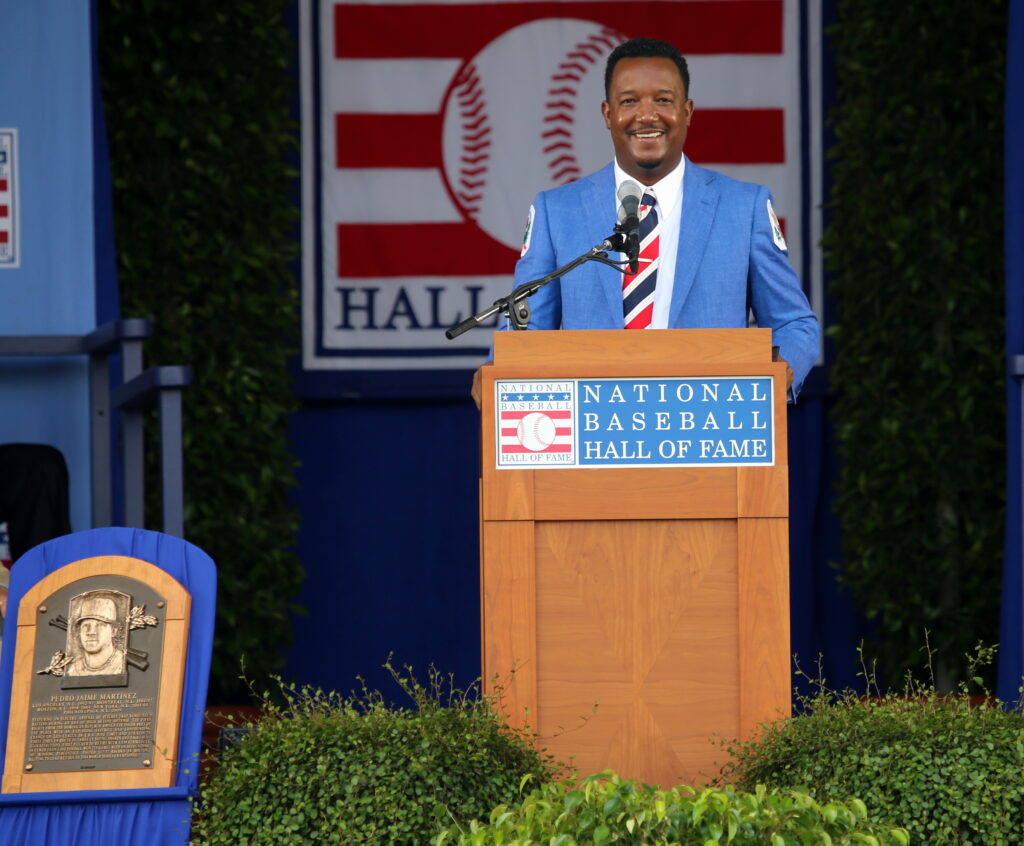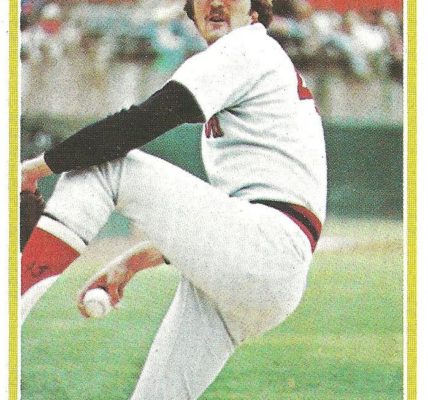Is Pedro Martinez the Greatest Pitcher of All Time?
As one who grew up watching the exploits of Pedro Martinez on the mound for the Boston Red Sox, I can say without a doubt that he’s the greatest pitcher I’ve ever watched. I can quote a bunch of numbers from Baseball Reference that are pretty impressive. But, others will say he only had five truly elite seasons. Looking at the raw numbers, that argument could certainly be made.
Overall, over 18 seasons of Major League Baseball, Pedro started 409 games (219-100 Win-Loss record), 3154 strikeouts against 760 walks (4.15 K/BB per 9 innings) and 83.9 WAR (by the measure of Baseball Reference). FanGraphs actually likes Pedro Martinez a bit more by their measure, 84.4 fWAR, thanks to calculating pitching performance by FIP rather than ERA. In 2015, Pedro Martinez was enshrined in the Baseball Hall of Fame in his first chance on the ballot.

Photo credit: Andrew Malone, CC BY 2.0 https://creativecommons.org/licenses/by/2.0, via Wikimedia Commons
Pedro Martinez’s Early Career
Pedro began his MLB career with the Los Angeles Dodgers in 1992. He had one start and one relief appearance. In 1993, he was given a full-time bullpen job. While he did make 2 starts, he appeared in 65 games overall, and over 107 innings, he recorded 119 strikeouts, but also collected 57 walks. All in all, Pedro was worth almost 3 WAR just as a reliever. He clearly had talent, and looked like he deserved a shot to prove himself in the starting rotation.
That chance wouldn’t happen in Los Angeles for Pedro, as he was traded to the Montreal Expos for second baseman Delino Deshields. This proved to be a steal for then General Manager Dan Duquette of Montreal. In 1994, the strike-shortened season, Pedro was a part of a pretty good Expos team, and made 23 starts with decent results. He finished with a 3.42 ERA, As a 22-year old, though, he was still a bit raw. He walked fewer batters than he had the season before, he also hit 11 batters. As it would turn out, though, it was because Pedro was never afraid to pitch inside, something that would make him a very special pitcher.
In 1995 and 1996, Pedro was a good, if not spectacular pitcher for the Expos. He was solid, but still struggled with his command a bit. Still, it was clear he had the talent to be an ace, something that in 1997 finally was realized.
The Greatest 5 Pitching Seasons on Record?
Pedro’s first truly dominant season in 1997 was one of the most dominant seasons on record for any pitcher. This included 13 complete games and 4 shutouts. His baseball card stats were phenomenal: 17-8, 1.90 ERA in 241 1/3 innings with 305 strikeouts against only 67 walks (for an 8.7 WAR according to Baseball Reference.) This earned him his first of 3 Cy Young awards.
This dominance led the Boston Red Sox to trade for Pedro after that season, surrendering top pitching prospects Carl Pavano and Tony Armas Jr. While his first season in Boston was nothing like his 1997 season, he still finished second in Cy Young voting. His numbers were definitely ace-worthy as well: 19-7, 2.89 ERA (63% below league average), 251 strikeouts to 67 walks, and was worth 6.9 WAR to Boston. He would be worth 45 WAR more to the Red Sox over the next six seasons (including an injury-plagued 2001 season). Four of those seasons may be four of the best pitching seasons (especially with the high-powered offenses of the American League) of all-time.
The next two years, 1999 and 2000, would be the two best of Pedro’s career. In 1999, Pedro had a win loss record of 23-4 in 29 starts with 5 complete games. He led the league with a career high 313 strikeouts against only 37 walks, a rare feat to be sure. He was worth 9 and a half wins that year to the Red Sox (9.5 WAR). The next season in 2000, he had a record of 18-6 again in 29 starts, but an even lower ERA and 284 strikeouts against 32 walks. He won the Cy Young Award in the American League both seasons. In 2000, he had the highest WAR of his career (11.4 WAR), adding about 11 wins to his team that year.
To put a WAR of 11.4 in perspective, Babe Ruth had a 11.5 WAR in 1920 and an 11.4 WAR season in 1924, Lou Gehrig had a 11.5 WAR in 1927. The last pitcher to post a WAR total that high was Roger Clemens in 1997 with 11.8 WAR for the Blue Jays. The only other pitchers beside Walter Johnson in the 1910’s and 1920’s to post higher single-season WAR totals are Dwight Gooden (13 WAR in 1985), Steve Carlton (12.1 WAR in 1972), and Bob Gibson (11.7 WAR in 1968). Johnson, Gibson, and Carlton are in the Hall of Fame. For a while, it appeared Gooden could have been, as well, were it not for his personal issues.
Pedro would have an injury-marred 2001, but still managed to start 18 games and produce a 4.9 WAR. It’s very likely barring the injury he could have had yet another Cy Young Award caliber season. He would return to form in 2002, however, with a 20-4 record and a 2.26 ERA (best in the league) and a 6.2 WAR.
However, it was clear that the injury had taken its toll on his strikeout rate, as he struck out “only” 239 batters in 199 innings. His walk rate was still excellent, however, as he walked only 40 in those innings. But he would not win the Cy Young Award that year, or in fact, ever again, as he lost the crown to Barry Zito. Looking at the numbers, however, Zito was not really as good as Pedro. Zito won 3 more games and made 5 more starts. He didn’t strike out as many as Pedro (182) and walked more (78) in 229 innings (only 30 more than Pedro).
In 2003, Pedro had the last of his 5 most dominant seasons. For a second straight season, his strikeout rate fell slightly and he walked a few more batters than usual. Still he went 14-4 (a record very deceiving because he received a great deal of no-decisions that year) with 2.22 ERA in 29 starts. He did increase his WAR total, however, with a mark of 7.8 WAR. He’d never reach that mark again.
The End of Pedro’s Dominance
Without a doubt, 2004 marked the end of Pedro’s run of dominance. While he was still a 5 WAR pitcher, he was clearly nowhere near the ace that he once was. Curt Schilling assumed that role that year with his 7.5 WAR. Schilling won 21 games against 6 losses, and Pedro won 16 against 9 losses. While win-loss record is not always indicative of true pitching performance, in Pedro’s case, he was becoming inconsistent. A 3.90 ERA was not a number you would see from Pedro. It would actually come out to be the third highest season total of his career. The good news is that Pedro Martinez would win his first and only World Series with the Red Sox in 2004.
After the season, the Red Sox and Pedro decided to move on, and Pedro signed a lucrative four year deal with the New York Mets. With certain advanced statistics measuring pitch quality being released around this time, it’s likely the Red Sox saw some warning signs that are backed up by the numbers looking back today. Looking at the advanced Pitch Values metrics, which became available starting with the 2002 season, we can see that Pedro was indeed not his prime self in 2004. For more information on what Pitch Values mean, here’s a great explanation from FanGraphs.
Basically, Pitch Values measure how each pitch affected the run expectancy of a given at-bat. It works both ways with hitters and pitchers. For a pitcher to have a positive Pitch Value means he prevented more runs with that pitch, while a hitter with a positive Pitch Value means he hit that pitch well.
Using these linear weights, we can see that Pedro’s once great fastball was just 0.32 runs above average per 100 pitches, after posting 1.1 runs and 0.93 runs above average in 2002 and 2003, respectively. His slider was just 0.58 runs above average, and he started mixing in a cutter that was 0.45 runs above average. His brilliant changeup was still strong at 1.56 runs, but that was much lower than 2002 and 2003 at 2.21 and 2.15 runs, respectively. More concerning was the fact that his curveball dipped to -0.19 runs below average, after being a strong 2.47 above average in 2002 and a solid 1.37 runs above average in 2003. Clearly, his pitch quality was deteriorating.
In 2005, on paper, Pedro looked great for the Mets. The Pitch Values even appear to back this up; his fastball was 0.94, his slider was 2.61, the curveball 2.19, and the change-up jumped to 2.87. His cutter was trash, although he threw it just 0.4 percent of the time. Still, for the first time since 2005, he failed to strike out at least a batter per inning, although he walked fewer batters than in 2004. This was even in moving to a league where he got to face opposing pitchers at the plate. He was still an ace, though aging.
But, in 2006, Pedro only pitched 137 innings in 23 starts and had a roughly league average 4.48 ERA. He was still a “good” pitcher, but his overall dominance was clearly gone and his arm troubles grew at that point. His changeup was a well below-average pitch in the 2006 season, “worth” -2.15 runs per 100 pitches. Meanwhile, his fastball was fine (1.25), but his slider was roughly average (0.38), and only the curveball (3.04) was still outstanding.
2007 would be a relatively lost season for Pedro, him having only 5 starts, although he pitched fairly well in those starts. In 2008, everything fell apart for Pedro and in twenty starts was practically a replacement-level scrub (-0.5 WAR). That looked like the very end for Pedro. The Pitch Values back up that in this limited sample size, his pitches were very much below average, too.
However, in the latter half of 2009, Pedro made a comeback with the Phillies. After doing fairly well in the minors, he was called up to the big club and made it onto the playoff roster. While he wasn’t spectacular down the stretch for the Phillies, he was certainly useful. Pitch Values suggest that his fastball was mediocre, but roughly average, while his slider was scrapped entirely for the cutter, but it was worth a run below average per 100 pitches and his change-up wasn’t much better (-0.79). Fortunately, his curveball was good enough (1.98 runs above average per 100 pitches) to at least make him a useful pitcher.
Pedro did win his only start in the NLCS. However, although he was still serviceable, the Yankees beat him in both of his World Series starts on their way to the World Series title. It became clear that while he did have a little left in the tank, his days as an elite pitcher were entirely behind him. Rather than try and hang on in a bullpen role, which he possibly could have, that was the end for Pedro Martinez as a Major League pitcher.
Pedro Martinez Compared to Other Hall of Fame Pitchers

Photo credit: Arturo Pardavila III, CC BY 2.0 https://creativecommons.org/licenses/by/2.0, via Wikimedia Commons
Pedro’s career 83.9 Wins Above Replacement (WAR) puts him in 56st place all-time. That total alone is a pretty special accomplishment. This puts him on par with Robin Roberts (career 86.1 WAR) and not far off from Gaylord Perry (career 90 WAR) and Steve Carlton (career 90.2 WAR). As all of those pitchers are in the Hall of Fame, Pedro’s in very good company.
Even if you don’t buy into the WAR statistic, looking at the career numbers of Roberts, Perry, and Carlton show that they pitched many more starts than Pedro. For Pedro to be able to amass the same Career WAR as pitchers with 600+ starts in only 409 starts is very impressive. Also, take into account that a good chunk of those later starts were with him wearing down considerably. Even though he had five truly dominant seasons, he also had five or six pretty good ones, on which most teams he would be considered an ace or at least a #2 starter.
Consider that Pedro had 5 out of this world seasons and 5 All-Star level seasons on top of that, you could say that he really had 10 very good years overall. He gave his teams tons of value whenever he pitched, except for that dismal 2008 season with the Mets. Even taking his lost season and that into account, he basically produced the same value as his potential Hall-of-Fame peers in far fewer starts.
Ryan Roberts had 609 starts over 19 years. Perry had 690 starts over 22 years. Carlton had 709 starts over 24 years. Pedro generally out-performed Roberts in 200 fewer starts and did almost what Carlton and Perry did in 300 fewer starts. Baseball fans can all agree that Roberts, Carlton, and Perry were all great pitchers that belong in the Hall of Fame. While he isn’t quite to the level of Bert Blyleven (94.5), Randy Johnson (101.1) or Greg Maddux (106.6), he’s in the neighborhood.
By the overall numbers, Pedro was probably the fifth best pitcher of his era, if you include Roger Clemens 100+ career WAR. But, no one had five consecutive seasons like Pedro did. No one dominated the baseball scene the way he did. Watching Pedro pitch was watching a masterpiece almost every time he took the mound.
The memories alone are probably what make us think he was the greatest of all time. As we can now see, his top seasons most certainly were among some of the greatest of all time for pitching (by WAR standards). However, while he’s not quite the greatest of all time, he was surely by far the greatest pitcher for about a five-year stretch.
Since retiring, Pedro continues to work with young pitchers and provides color commentary on baseball broadcasts for TBS.
Thanks for such an awesome career, Pedro!
Photo credit: All pictures courtesy of Wikimedia Commons
Updated 8/29/2022








RECENT COMMENTS